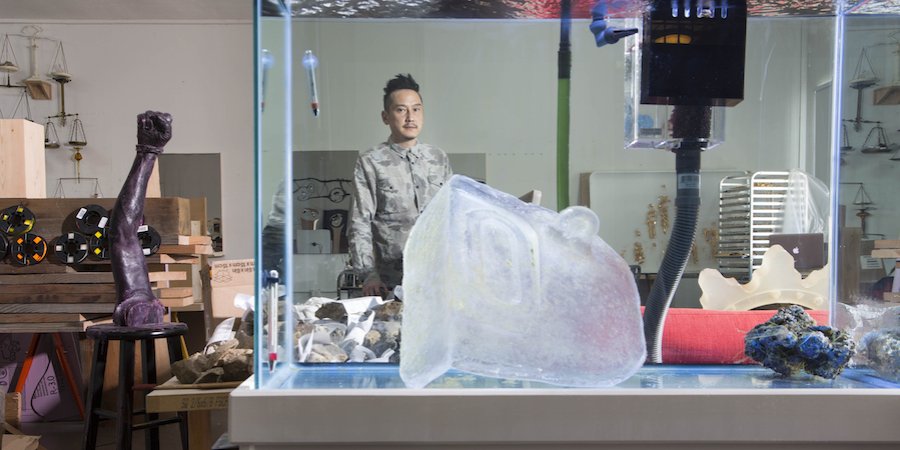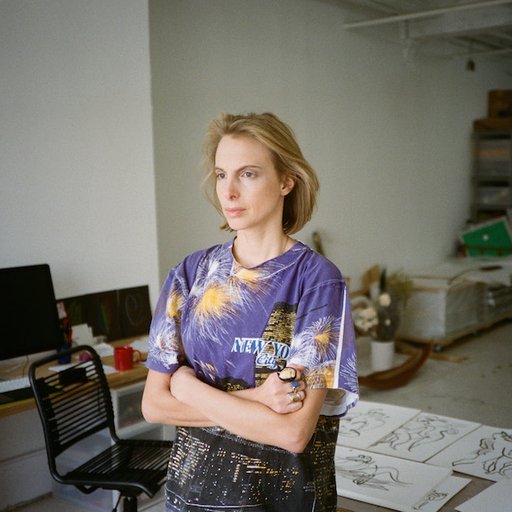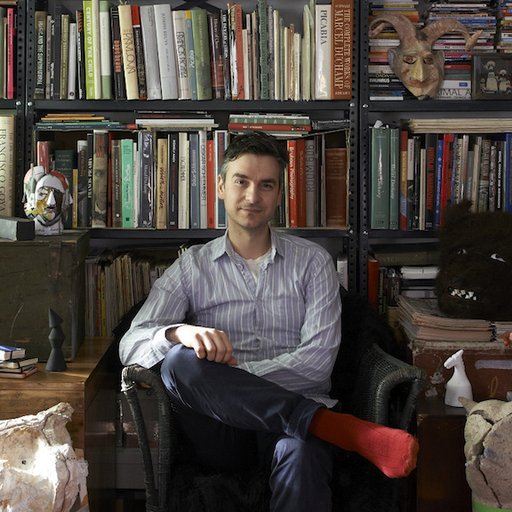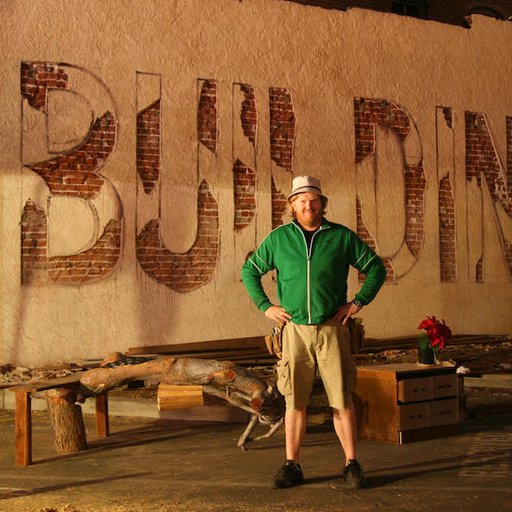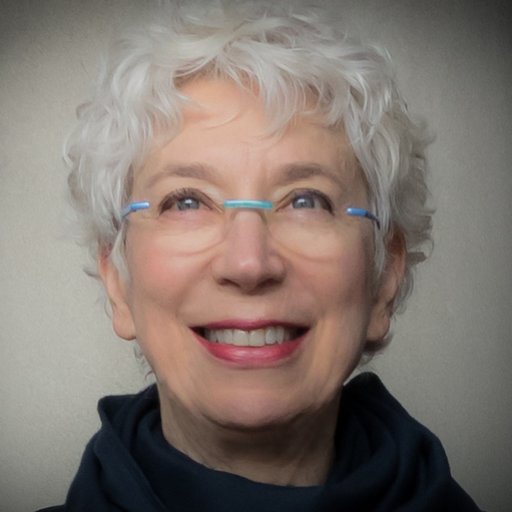The Los Angeles-based conceptual artist Glenn Kainois compelled by the provisional ecosystems that pop up in the midst of political activity, for instance in Tahrir Square, which he visited before the Egyptian revolution, and, more recently, in Ferguson, where he stood with protesters. Over the past few years, he has also been studying a different sort of self-forming community, one found in the ocean. Today these two threads of inquiry converge at the third edition of the Prospect New Orleans biennial (aka P3), where Kaino has debuted Tank (2014), a series of gurgling, blue-lit aquariums containing colorful coral polyps—which Kaino notes look like the country outlines on a map—clustered across reproduced fragments of a military tank. It’s just the sort of delightful confection of seemingly unrelated materials and ideas characteristic of the artist whose work often joins politics and poetics.
Kaino refers to the process behind his combines as “kit-bashing,” a term used by model-makers to describe the act of disregarding a set's instructions in order to achieve different, improvisatory ends. In his early work, Kaino took this approach literally, using specimen pins to display the different pieces from kits in shallow, tub-like containers. Recently, however, he’s been uniting more abstract cultural flotsam in his work.
Along with the piece in New Orleans, he has collected rocks from political hotspots across the world for a series of works featured in his current show at Kavi Gupta in Chicago, “Leviathan.” Some of the pieces scatter the rocks, painted in candy colors like Fruity Pebbles, on the floor; one installation involves them lining an industrial conveyor belt that teeters precariously on its front wheels, apparently balanced in the air. In Bridge, meanwhile, 2013 a public-art sculpture installed in Washington, D.C., Kaino created an undulating chain of hundreds of fiberglass-cast arms of 1968 Olympic champion Tommie Smith, who famously raised his fist in solidarity with civil rights groups.
Artspace conducted an email interview with the artist—who was included in the 2004 Whitney Biennial, and who by day works as the director of the Oprah Winfrey Network’s digital team—about his busy year, and the possible meetings of politics and art.
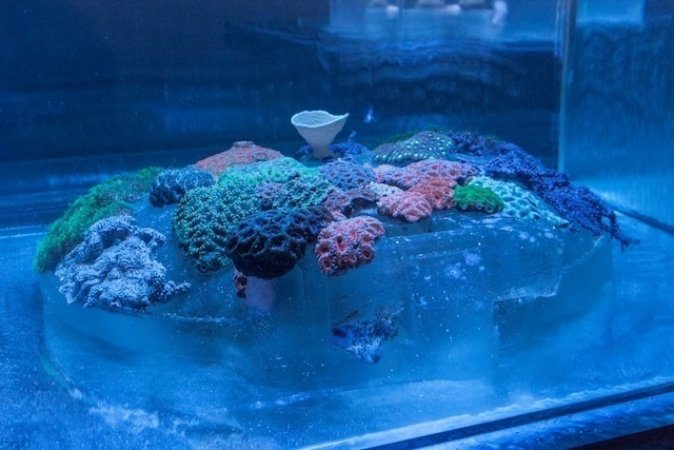 Tank (2014)
Tank (2014)
Let’s start off with Prospect New Orleans. What was the genesis of Tank?
For P.3 I’m debuting a new work produced with Grand Arts in Kansas City. It is a multiyear experiment wherein I cast an M-60 Abrams tank into smaller pieces made from clear resin and grow corals on them. This slow and intense process functions as a meditation on the de-prioritization of human subjectivity and the ownership of voice. In thinking about the biological, about what connects us to each other and to the world, this was a way to visualize and give form to the exploration.
I found that the U.S. Military had a program called "Reef-Ex" that was created to dump military detritus on the bottom of the ocean, starting with used Army tanks. The tanks slowly were reclaimed into reefs. I was struck by the poetics of some of the smallest, non-intelligent organisms in the world reclaiming the instruments of displacement of some of the most sentient.
Corals are impulsive organisms that behave with a violent, colonizing instinct, and I thought I could create a sculptural metaphor using these biological codes that paradoxically was both beautiful and violent.
 Don’t Bring a Gameboy to a Gunfight (2014)
Don’t Bring a Gameboy to a Gunfight (2014)
In your show at Kavi Gupta you also harmonize political ideas and formal play. Are you dealing with any of the same concepts there?
The show at Kavi Gupta opened first, but it actually started after I had already been busy working on the Prospect project for a while. I began to think about zero-sum games as they pertained to geography and terrain, and metaphorically, the limits or boundaries of a contained discursive framework. So I started to create elaborate balance games in the studio, and then layered other ideas and forms on top, really to consider questions regarding subjectivity and voice and the relevancy of art practice.
 Suspended Animation (2014)
Suspended Animation (2014)
In the show, there are bomb cases stacked like Jenga pieces and old-fashioned two-pan scales hung as a mobile. There’s also a suspended conveyor belt balanced on its front wheels. Across the surface, you arrange rocks from political flashpoints across the world—Cairo, Afghanistan, Athens, Turkey, China, Thailand, Yemen, and now Ferguson. First off, whoa, how is it standing? Secondly, can you talk about the bottled-up energy and potential of these sculptures?
It’s standing in balance. The piece is about potential energy, starting with the idea that a conveyor belt is a very mechanical way of increasing potential energy as it moves objects further from the ground, and then asking questions: How does one elevate the agency, meaning, and value of objects from detritus to cultural artifact or political device? What is the balance between those systems? And on a level field, is the state of parity or stability in and of itself a spectacle to be marveled at?
There’s also a complicated question encoded in the politics of obtaining the rocks, which were sent to me from people in different parts of the world for inclusion in the work. From an anthropological sense, this helps investigate the privilege of voice and in this case, the asymmetrical power balance of the access to and context for cultural construction.
 Excalibur (2014)
Excalibur (2014)
Does the gallery setting restrict the propulsive force you describe? Excalibur is a slingshot ready to be launched—recalling David's victory over Goliath with a humble rock—but it's in fact made of bronze, and empty. Likewise, you’ve retired the rocks from their sites of political unrest. Could you talk about the glimmer of social possibility you see inside of the art world?
Excalibur is the paradox within which the entire show resides. The gallery itself seems to be aiming at the viewer, but the payload is empty. It also functions as a sword in the stone metaphor, putting the viewer on trial. You are confronted at the entry to the show and at the exit—perhaps it means something different on the way out.
I believe in the infinite possibility of art to create and incite social change. This is not necessarily only in a direct, street-level function, though creating support systems for activist projects is one way. When art functions as a public forum for the proposition and critique of radical ideas, it is very powerful.
You title the show after Hobbes’s treatise, Leviathan. As an artist, how do you dramatize critical and/or political theory, or relate it to lived experience?
The title was intended to initiate a context and critique, yet the exhibition isn’t an illustration. The artworks in the show are both performances that have yet to happen, and tracings and records of events past, all reconciled in the present.
I have a dynamic, ever-evolving relationship with the notion of theory-into-practice. My work has always attempted to reconcile irreconcilable materials as a way to make tangible moments in which the impossible is given form, if just for a moment or a glance.
 In Search of a New Model (2011)
In Search of a New Model (2011)
You came to be known in the early 2000s for your “kit-bashing” pieces. In one work, for instance, you arrange small toys gilded in gold. Like some of the work at Kavi Gupta, they offer alternative ways of imagining systems.
Yes, I think of my entire practice as a way of conceptual ‘kit-bashing.’ The works you are referring to are my ‘pin-drawings,’ which are part of my process of creating all of my work. Each idea includes a series of contextual works, including the pin pieces, which are conceptual sketches and formal reminders of how the work creates its own gravity, bringing together seemingly disparate fragments of ideas, form, and materials.
 Bridge (2013)
Bridge (2013)
Critics have lauded Bridge (2013), a sprawling installation that was built around a fiberglass cast of the arm of Olympic gold-mentalist Tommie Smith, who raised his fist in a sign of solidarity with civil rights groups in 1968. Recently, it’s drawn crowds in D.C. What was the animating idea? Does the gesture mean something different today than it did in 1968?
The project began when Tommie generously shared several stories with me about the salute and that moment. I remarked to him that I noticed an interesting disparity between his memory of that event and the way history had recorded it. I asked if he would consider collaborating on an art project where I would symbolically take his arm off his body and create something that could be realized and circulated contemporaneously, allowing him to be both spectator and witness to a new history. Two weeks later he was out in Los Angeles from his home in Atlanta and we were casting his arm.
People have had a great reaction to the work, in both the visual and political sense. Generationally it seems to be bridging the gap, both literally and metaphorically.
Another kind of balancing act: your day job and your art. You’ve had a fascinating career in the technology and marketing fields, currently as the senior vice president of digital at the Oprah Winfrey Network, and before that, at Uber and Napster. Does your day job feed your artistic life? I think of the spinning wheelie-chair at the Whitney Biennial in 2004—transforming the corporate Internet-boom into a throne-like prop—as well as the towering Emerald City sand sculpture, which could be a comment on capitalist constructs of power.
These projects are good examples of how my practice explores ideas and slippages between existing cultural systems and art. All of my engagements with commercial media begin with organizations that I work with that understand I’m an artist and will function in that propensity and with that approach. There is no different day job per se; I have always run my studio, and during periods of my career I have also run other organizations. The worlds were more separated when I was younger and was just paying bills trying to make artwork. Then I learned how to make them work together.
Anything else down the pipeline?
I’m working on an exhibition that will open at Honor Fraser gallery in Los Angeles in January, and a commission for the City of Los Angeles as part of the Sixth Street Viaduct Replacement Project. The show at Honor Fraser will be about the layering of knowledge and how seemingly exhausted materials, ideas, and positions have the potential to become catalysts and instigators of transformation.











